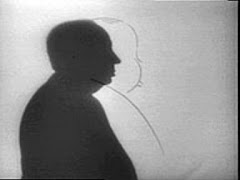El lugar sin límites (Place Without Limits, Arturo Ripstein, Mexico 1977)
Roberto Cobo as 'La Manuela’ dances to the intermedio from the Spanish zarzuela (operetta) La leyenda del beso (The Legend of the Kiss, Soutullo/Vert, 1924), as Pancho (Gonzalo Vega) watches. Then they dance together to the pasodoble 'El relicario'
Apologies for the lack of subtitles, but I still thought it worth posting this clip of the most wonderful sequence from El lugar sin límites. The very beginning of the 7 minute long dance segment is missing from this clip, but below I've given a synopsis of this section of the film, from the sequence before the one posted here up to several sequences later with the tragic ending of the film as a whole. So, many spoilers follow:
Octavio and a scared Pancho go to Don Alejo’s ranch to settle Pancho's debt and to establish the young man’s independence once and for all from his former patron. Invigorated by the experience, Pancho and Octavio ignore Don Alejo’s prohibition on visiting the brothel. When they arrive, Pancho (the younger, dark haired man) asks for La Manuela (in the red flamenco dress), but s/he hides. Japonesita (the youngest of the women, and La Manuela's daughter) entertains the men, while Manuela spies through the window. When Octavio goes off with another prostitute, Pancho and Japonesita continue their earlier sexual encounter. Pancho becomes violent, however, and again demands Manuela’s presence. Finally (the section in the clip posted here), s/he makes a dramatic appearance in her red flamenco dress, dancing for him and acting out a story set to music.
The story La Manuela tells in his/her dance (his/her own invented ‘legend of the kiss,’ only very tangentially connected to the original zarzuela plot) involves dramatic action: s/he attempts to makes Pancho perform the role of the man in the legend who is kissed by a mysterious woman in a bewitched wood, against his will at first; Pancho's will is worn down in inverse proportion to his physical and affective involvement in the spectacle.
As Octavio, Pancho's macho friend, returns, Manuela and Pancho dance together, amid much laughter. But then they kiss on the lips. Octavio sees the kiss and confronts Pancho, who denies everything, and turns his humiliation into rage against Manuela. S/he runs away from the brothel, hampered by tight clothes, poor roads, and sheer terror. The two men follow him/her in Pancho’s truck to the outskirts of the town, just past Don Alejo’s ranch. He and his foreman are alerted by the noise and follow the truck to where Pancho and Octavio finally catch up with Manuela. Don Alejo decides not to go to Manuela’s aid, and watches as Pancho beats him/her to death and then flees in his truck with Octavio. Don Alejo approaches Manuela’s corpse and promises that the two men will be brought to justice, and that they won’t defy him again. As the truck passes by the brothel on its way out of the small town of El Olivo, Japonesita muses that her father will return, battered and bruised by his/her exploits as always. She goes to the bed they shared and puts out the oil lamp.






